Watermelon (Citrullus lanatus) is a warm-season crop in the Cucurbit family. Watermelon is a warm season crop. Popular fruit for fresh consumption and agro-processing, such as juice making. It contains about 6 % sugar and 92 % water by weight.
Watermelon cultivars differ in such horticultural traits as fruit shape (round to oblong), rind pattern (crimson type, jubilee type, all sweet type, black/dark green), fruit size (7 to 35 pounds), and flesh color (red, dark red, pink, orange, yellow and white).
Watermelon varieties fall into three broad classes based on how the seed were developed: open-pollinated, F1 hybrid, and triploid or seedless.
The crop is grown commercially in areas with long frost-free warm periods. Plants must be grown at a wide spacing because of their long, trailing vines. Watermelon can be grown on a wide variety of soils. Sandy loams are the best for early crop, while high yields are recorded in loamy soils. Well drained soil with high organic matter is preferable for the cultivation.
Watermelon fruit will keep for two to three weeks after harvest if they are stored properly at 10 to 15°C and 90% humidity. Besides whole watermelons, it is becoming popular to sell watermelon in pre-cut halves, quarters, slices, and chunks.
The fruit is a source of p0otassium, vitamin A, vitamin C, folate and amino acid. It contains some of the most important antioxidants in nature- e.g., lycopene
Watermelon
Why Napier Grass Is Ideal Fodder for Dairy Cows
-
Napier grass ( *Pennisetum purpureum* ), commonly known as elephant grass,
is one of the most valuable fodder crops for dairy farmers in tropical and
sub...







